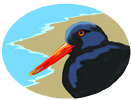
A wonderful bird is the pelican / Its bill can hold more than its belly can. Well, actually itís the pouch attached to the bill which can hold three times as much as the stomach. Everyone recognizes the Brown Pelican. Itís that four-foot bird on the coast with that giant bill. At eighteen inches the Brown Pelican has one of the longest bills of any bird. It is strictly coastal bird. They travel in a line over the water, each taking a turn flapping and gliding on those seven-foot wings.
Brown Pelicans eat fish almost exclusively. They perform spectacular dives, sometimes from sixty feet up, twisting and plunging into the water head first. They donít carry fish in their pouch - they use it as a fish net. They tip the point down to drain the water before swallowing the fish.
Brown Pelicans might be seen on our coast at any time, but are most common in July through November. We usually see either young pelicans that have brown heads, or nonbreeding adults, whose heads and necks are white with light yellow on the crown and gray pouches. The breeding adults have a bright yellow head, white forehead, and a sport gorgeous rich brown on the back of the neck and a red pouch.
On our coast, Brown Pelicans have historically nested as far north Point Lobos but now are restricted to Southern California, especially the Channel Islands, and south into Mexico. Females do not breed until three years of age and males until even older. In breeding pairs, the males collect the nesting material and the female builds the nest. They will build nests colonially, in low trees, on cliffs, or on the ground in shallow depressions.
They lay three eggs. If one survives to fledge at three months, itís a successful year. In 1970 there were only five Brown Pelicans reported to have fledged in the entire state. This failure was due to the build up of DDT and other chlorinated hydrocarbons in the adults, causing the egg shells to be too soft and break prematurely.
Brown Pelicans were placed on the Endangered Species List. On the Atlantic coast, Brown Pelicans were removed from the list in 1985. The Brown Pelican was removed from the list throughout its range in 2009. It presents another example of natureís ability to come back when given half a chance.
Brown Pelican photo by Ron LeValley www.levalleyphoto.com
A wonderful bird is the pelican,
His bill will hold more than his belican,
He can take in his beak
Enough food for a week
But I'm damned if I see how the helican!
--Dixon Lanier Merritt
